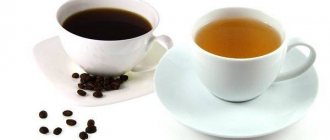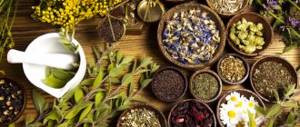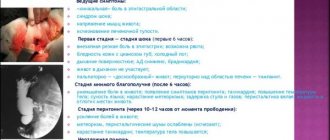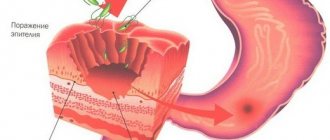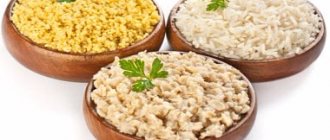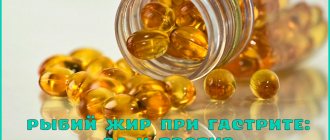Minus 24 kg without leaving home! A Muscovite who lost weight in quarantine “blew up” Russia with her recipe
Gastric and duodenal ulcers are a serious disease that requires treatment to avoid exacerbations. In addition to the doctor’s medication recommendations, adherence to a therapeutic diet aimed at sparing the stomach is indicated. Proper nutrition will help relieve pain during exacerbation and promote effective treatment and recovery.
General principles of diet for stomach ulcers
Knowing and adhering to the general principles of the diet that is used for stomach ulcers, you will be able to create your own menu as correctly as possible and not aggravate the course of the disease.
Among them are:
- Balance. You cannot deprive the patient of the calorie content of his meals. The daily menu should be balanced, and the energy value should be no less than 3000 kcal.
- Fractionality. Breaks between meals should not be more than three hours.
- Minimum portion size. Ideally, each portion of food should fit into cupped hands.
- Prohibition on fried and golden-brown foods.
- Prohibition of very hot or very cold food. Dishes that have a temperature above or below 30 °C inhibit the function of enzyme formation and slow down the process of restoration of epithelial tissue of the stomach. This rule is especially relevant at the time of exacerbation of a stomach ulcer.
- Refusal of products that increase gas formation.
- Complete refusal or minimizing the amount of salt consumed.
- Increasing the volume of water to 2 liters, in the absence of thyroid diseases and pathologies of the urinary system.
- Avoid carbonated drinks and alcohol.
- Refusal of any foods that increase the production of gastric juice.
- Heat treatment of dishes is allowed: stewing, boiling, steaming, blanching.
- Priority is given to gentle food that does not irritate the stomach wall.
- The principle of sparing. Mechanical stomach sparing involves selecting certain foods to eat at one time. Chemical sparing consists of eliminating foods that irritate digestive secretions.
- The principle of zigzag nutrition. He assumes that for short periods of time the patient is allowed to eat foods from the prohibited list (within reason), and then he is returned to the diet menu. This principle is intended to serve as a kind of training for the gastrointestinal tract and is used only at the recovery stage.
- The principle of individuality. That is, when creating a menu, you cannot be guided by the same principles for everyone. Much depends on what stage the disease is at, where the ulcer is located, what the patient’s age is, what his body weight is, whether there are concomitant diseases, etc.
- Calculation of food digestion time. So 200 ml of water, tea or broth will stay in the stomach for an average of 1.5 hours. After three hours, meat, boiled vegetables, apples and bread will leave it. Fatty fish, fried meat, and legumes last the longest there – up to 5 hours.
As for the timing, the diet must be followed for at least one year after an attack of exacerbation of the disease. The main goal of dietary nutrition in this case is to accelerate the regeneration of the mucous membrane lining the stomach and normalize the digestion process.
What foods should you not eat if you have an ulcer?
The treatment menu is developed taking into account the patient’s taste preferences. When creating a menu, it is necessary to consider which foods cannot be eaten if you have a stomach ulcer, and which should be limited. Dietary food includes a list of prohibited foods, which is reflected in Table 1.
Table 1. Prohibited products and requiring restrictions
| Categorical prohibition | Limitation |
| Alcoholic and carbonated drinks, coffee, tomato juice, sour berry juices, kvass | Strong tea, juices with pulp |
| Hot spices - horseradish, mustard, hot red and black pepper | Spices - nutmeg, paprika, cloves |
| Mushroom, meat, fish broths, strong jellied meat | Nuts, seeds, peasant butter, chocolate, halva |
| Rye flour bread, yeast baked goods | Fresh wheat flour bread, dumplings, dumplings |
| Lard, liver, offal, meat with fatty layer, sausages, mushrooms | Pork, lamb, hard-boiled eggs, seafood - shrimp |
| Full-fat milk, cottage cheese, ice cream, cream, fermented baked milk | Fermented milk products - kefir, sour cream |
| Salted, pickled vegetables, raw onions, sorrel | Some vegetables - cabbage, radishes, radishes, cucumbers, green peas, avocado |
| Citrus fruits - lemons, tangerines, oranges, sour fruits, grapes, pomegranates | Sour berries |
| Pearl barley, millet porridge | Wheat, barley porridge, pasta |
What should you not eat if you have a stomach ulcer?
All products that irritate the gastric mucosa, increase gas formation, take a long time to digest, or contain large amounts of salt are prohibited.
You should definitely avoid:
- Primary boiled meat and fish broths and prepared soups from them;
- Any dishes made from any mushrooms;
- Okroshka and cabbage soup;
- Any fatty meat and fish are prohibited, this also includes lard and caviar;
- Smoked products, most sausages (sometimes, during the recovery stage, you are allowed to eat a little boiled sausage or ham);
- Canned products, as well as pates;
- Dairy products with acid, for example, ayran, tan, etc. (Kefir is prohibited only during an exacerbation and +5 days after the attack has stopped);
- Fatty dairy products: buttermilk, condensed and whole milk, cream and cheeses;
- Hard-boiled eggs, as well as scrambled eggs (soft-boiled eggs are allowed);
- Among the cereal dishes prohibited are pearl barley, semolina porridge, wild rice and corn, as well as bran granules and muesli;
- It is worth limiting the consumption of cucumbers and tomatoes, as well as tomato paste;
- Products of plant origin that can irritate the mucous membrane of the damaged organ: sorrel and rhubarb, garlic and onions;
- Berries and fruits with acid: gooseberries, figs, grapes, currants, lemons, oranges, limes, tangerines, pineapples, etc.;
- Nuts, dried fruits and apricots are prohibited;
- Any hot, salty and spicy sauces: mustard, horseradish, ketchup, vinegar;
- Ice cream and chocolate;
- Strongly brewed drinks (strong tea, coffee);
- All carbonated drinks;
- Alcoholic drinks;
- Rye bread, pastries.
When processing meat products, cartilage and veins should be removed.
Prohibited Products
There is a list of products that are prohibited while using a diet for gastric or duodenal ulcers, these include:
- Broths cooked with meat and fish, which contain a large amount of extractive organic compounds. Having a pronounced stimulating effect on the organs of the digestive system.
- Coarse pearl barley, barley, corn grits.
- Fatty meats (pork, duck, goose), fried meat dishes, smoked meats, sausages.
- Any sour vegetables or fruits.
- Oily fish (mackerel).
- Bakery products made from puff pastry, butter dough, coarse rye bread.
- Spices, marinades, tomatoes and products made from them (tomato paste, ketchup, sauces).
- Alcohol, strong black tea, coffee, sparkling water, sour drinks.
What can you eat if you have a stomach ulcer?
The list of foods that are allowed to be consumed for stomach ulcers is quite extensive, so the patient does not have to go hungry:
- Bread made from wheat flour. But it is important that it is not just baked. It’s better if a day has passed since it was made.
- Baking from unleavened dough (not yeast) in small quantities. The filling for such pies can be: fish, apples, cottage cheese or lean meat.
- Crackers, cookies, but not sweets, and biscuits are also allowed.
- Meat soups, but the most important rule when preparing them is the use of secondary broth. That is, after boiling, the broth is drained, the meat is again filled with clean water, and soup is prepared from this. As for the meat itself used to cook the soup, you can take either chicken or beef.
- Cereal soups without meat component.
- Cottage cheese, sour cream, yogurt, fermented baked milk. You can also eat cheese, but it is better to grind it. Preference should be given to unleavened cheeses.
- Main courses made from lean meat containing a minimum amount of veins. You can take rabbit, turkey, beef, chicken meat. As for the dishes themselves, the priority is zrazy, meatballs, cutlets, souffle, meatballs, but not fried. It's best to steam them.
- Fish, but not fatty varieties. An excellent solution is minced fish dishes. Only the fish needs to be boiled or steamed (can be in the oven, in foil)
- The patient needs to include eggs in his diet. You can cook an omelet from them, or boil them soft-boiled.
- Boiled cereals and pasta are useful. You can consume rice, rolled oats or buckwheat porridge (except semolina).
- Berries and fruits must first be peeled and ground until pureed. You can also bake apples and pears.
- As for desserts, you can diversify your own menu with marmalade, honey, marshmallows, marshmallows, jam, preserves. Jelly, mousse, jellies, and creams do not harm the damaged gastric mucosa.
- Suitable drinks include decoctions of rose hips and wheat bran, freshly pressed juices half diluted with water, loosely brewed teas, as well as compotes.
- You can consume olive and sunflower oil, unrefined, as well as unsalted butter in small quantities.
- White milk sauce can be used as a dressing for dishes.
List of recommended products
The composition of the “Table No. 1” menu usually prescribes the consumption of the following products:
dried or yesterday's bread made from premium flour;- vegetable broths, soups made from lean fillet, well-cooked cereals, slimy soups or puree soups from cereals or vegetables, it is permissible to eat milk soups;
- as a dressing for soups, you can use a mixture of eggs and milk, small pieces of butter;
- olive or linseed oil;
- boiled or steamed steaks from lean fillet of beef, chicken, turkey, red and white fish, low-fat pork parts;
- You can also make boiled steamed cutlets and meatballs from meat; it is permissible to mix unsalted minced meat without spices with various well-cooked cereals;
- boiled offal and various dishes made from them, for example: soft puddings or cutlets. Among those allowed: liver, tongue;
- rolled oats porridge with water or a mixture of water and milk, buckwheat, semolina.
notePorridges should be very thoroughly pureed, to a semi-viscous consistency;
- boiled and mashed vegetables: potatoes, cauliflower, carrots, beets. Gradually, dishes can be complicated and vegetables can be prepared into stews or puddings;
- dairy products with low fat content and acidity, without dyes and preservatives;
- boiled eggs and various soft dishes made from them, for example: omelet;
- berries (necessarily ripened, without acid) and fruits are added to the menu gradually, only after transition from the acute stage. It is acceptable to eat bananas, apples, pears;
- various types of herbal infusions and teas from medicinal herbs (chamomile decoction, mint, rose hips, special mixtures for the treatment of acute and chronic ulcerative pathologies of the stomach and duodenum;
- viscous oatmeal jelly or from non-acidic fruits and berries;
- when the symptoms of the disease weaken, it is permissible to add small amounts of honey, marshmallows, marshmallows or low-sugar marmalade to the menu;
- healing mineral waters (Essentuki, Borjomi).
Proper nutrition for peptic ulcers of the gastrointestinal system includes not only compliance with the standards of preparation and consumption, but also a correctly composed menu.
Important
In order for the diet to be beneficial, you need to take into account the stage in which the disease is located, the severity of the course and other individual characteristics. That is why it is best to entrust the preparation of a diet according to the “Table No. 1” nutrition list to a gastroenterologist.
In the acute stage of the disease, only viscous porridges made from a mixture of water and 1% milk, and slimy jelly without added sugar are allowed for consumption. You need to drink plenty of fluids and be sure to take medications prescribed by your doctor to relieve acute symptoms.
After the disease begins to subside with the help of gentle nutrition, other foods are gradually introduced into the daily diet, carefully, one at a time. If, after adding any new dish, your health condition worsens, this component must be immediately excluded from the menu and again switched to a more gentle composition of products.
Despite the fact that the transition from normal everyday eating to a diet will seem bleak and tiring, it is important to remember that it is the correct composition of the menu that will help the body recover faster and completely get rid of the inflammatory disease.
Kuznetsova Irina, medical observer
7, total, today
( 194 votes, average: 4.76 out of 5)
Champignons: benefits and harm
Brewer's yeast: benefits and harms
Related Posts
What should you eat if you have a stomach ulcer?
List of foods that will help you speed up your recovery:
- Cauliflower
- White cabbage
- Radish
- Apples
- Blueberry
- Raspberries
- Blackberry
- Strawberry
- Cherry
- Bell pepper
- Carrot
- Leafy greens
- Liquorice
- Foods rich in probiotics, such as yogurt, kefir (kefir is prohibited during an exacerbation period)
High-fiber foods can prevent excess stomach acid secretion, which can reduce ulcer pain and protect the stomach lining as the ulcer heals.
Many high-fiber foods are also good sources of polyphenols, plant substances that have antioxidant, anti-inflammatory and protective properties that help improve healing.
What is a stomach and duodenal ulcer?
Peptic ulcer is a disease in which defects (ulcers) form in the human stomach and (or) duodenum.
The disease is characterized by a chronic course and cyclicality: the disease undermines the health of its owner for years, periods of exacerbation are replaced by deceptive calm. Most often, the ulcer makes itself felt in spring and autumn.
Causes
The leading role in the development of the disease is played by the spiral-shaped microbe Helicobacter pylori, which damages the mucous membrane of the stomach and duodenum.
The fact is, an ulcer does not develop without a number of additional factors:
- stress, anxiety, depression. bad heredity;
- unhealthy diet: eating rough and spicy foods.
- alcohol abuse.
- smoking.
- uncontrolled use of certain medications (reserpine, corticosteroid hormones, aspirin).
Once in the stomach, Helicobacter begins to actively multiply. It produces special enzymes (urease, proteases) that damage the protective layer of the mucous (inner) lining of the stomach and duodenum, disrupts cell function, mucus production and metabolic processes and causes the formation of ulcers.
Symptoms
- First of all, a person is signaled by pain in the upper half of the abdomen about the occurrence and development of a peptic ulcer. Night and “hunger” pains are disturbing, in which a person needs to eat something in order to “extinguish” the pain.
- Pain in peptic ulcer disease has a clear rhythm (time of occurrence and connection with food intake), periodicity (alternation of pain with periods of its absence) and seasonality of exacerbations (spring and autumn). It is typical that pain from a peptic ulcer decreases or disappears after eating and antacids.
- One of the common symptoms of peptic ulcers is heartburn, which usually occurs 2-3 hours after eating. Nausea, vomiting, “sour” belching, constipation - these nonspecific symptoms may also indicate an ulcer. Appetite in case of peptic ulcer is usually preserved or even increased, the so-called “painful feeling of hunger.”
In some cases, the ulcer may be asymptomatic.
If the disease is not treated, the ulcer spreads deep into the stomach wall. This process can result in life-threatening complications: perforation, in which a through hole is formed in the wall of the stomach or intestine, or bleeding.
It goes without saying that only a doctor can make a diagnosis of this disease, like any other, based on his own experience and the results of laboratory tests.
Is it possible to eat, drink...?
It would seem that the list of permitted and prohibited foods for consumption with a stomach ulcer is quite clear. However, after visiting a doctor, most patients have a number of questions regarding one or another unspecified product.
Therefore, it is worth answering in more detail the most popular questions that arise among people suffering from ulcers:
- Is it possible to drink kefir, fermented baked milk, yogurt? It is worth dealing with each of these fermented milk products separately. So kefir is prohibited during the period of exacerbation of the disease, as well as 5 days after the attack passes. After this time, you can consume kefir, but it is important that it is fresh and non-acidic. The main thing is to warm it slightly before using it internally. You can add a spoonful of vegetable oil to the drink, which will allow the existing ulcer to heal faster. Yogurt is one of the priority food products for the treatment of ulcers, since the bifidobacteria it contains have a detrimental effect on Helicobacter pylori. If possible, you should prepare this product yourself, at home. As for fermented baked milk, it is also allowed for this stomach pathology. However, it is worth buying this fermented milk product with minimal fat content.
- Is it possible to eat cucumbers and tomatoes? When the disease is in the acute stage, vegetables such as cucumbers are prohibited for consumption. After the remission stage has begun, you can gradually include them in the diet, but in small quantities and without the skin. This vegetable is added to salads in various forms, but it is best to grate it. Tomatoes, as well as cucumbers, are prohibited during an exacerbation of the disease. This is due to the fact that they help reduce the rate of ulcer healing and slightly increase the acidity of gastric juice. When the exacerbation of the disease has been eliminated, you can use tomato fruits in the daily menu, but first douse them with boiling water and remove the skin.
- Can you eat banana? Bananas are allowed for consumption by patients with gastric ulcers. Once in its cavity, they envelop the organ, thereby reducing the acidity of gastric juice. This helps eliminate pain and speed up healing of the existing ulcer. In addition, bananas have increased nutritional value.
- Is it possible to have cheese or cottage cheese? Cottage cheese is a product that must be on the table of a patient with a stomach ulcer. It does not contain anything that could provoke an attack of the disease or aggravate the patient’s condition. In fact, cottage cheese is coagulated milk protein, without whey, which is endowed with vitamins B, PP, A, and iron. Therefore, it has undoubted value for sick people. Moreover, cottage cheese can be purchased both in the store and prepared at home. The product can be used to prepare many dishes: casseroles, soufflés, mousses, creams, etc. It is worth choosing cottage cheese that has a low fat content. Cheese is also a valuable product in the diet of a person with an ulcer. It contains a lot of easily digestible protein and amino acids, as well as calcium. The main thing is to give preference to cheeses that have low fat content and low salt content.
- Can I have eggs? Eggs are among those products that have high nutritional properties and provide an excellent opportunity to compensate for the lack of vitamin A, B6, B2, E, phosphorus, calcium, cobalt, glands and other trace elements in the diet. The protein that makes up the egg is perfectly absorbed by the human body, but it is important to prepare it correctly. You should not boil or fry eggs for a long time; patients with ulcers are advised to consume this product soft-boiled or in the form of an omelet. A raw egg will be useful, but in this case the risk of salmonellosis infection increases.
- Can I have watermelon? Patients with stomach ulcers are prohibited from eating watermelon. This is due to the fact that it causes increased secretion of gastric juice, increases its acidity, which will contribute to the exacerbation of the disease. During the period of remission, you can include a small amount of fresh watermelon in your menu, but you should not do this on an empty stomach.
- Can I have seeds? Seeds are prohibited for stomach ulcers, as they irritate the mucous membrane, can further injure it and aggravate the pathological process. In addition, they contain difficult-to-digest fats, which negatively affect the course of the disease. After the seeds enter the stomach of a person with an ulcer, he will begin to experience pain as the acidity level increases, flatulence and complications from the gallbladder are often observed. You should not consume seeds even during remission, as this may exacerbate the ulcerative process.
- Can I have garlic? During the period of exacerbation of the disease, a product such as garlic is strictly prohibited. When the patient's condition reaches stable remission, it is allowed to be eaten. However, patients with a history of ulcers should first steam the garlic, or add it to pureed dishes: mashed potatoes, boiled cereals, etc. You can add it in very small quantities when stewing or boiling dishes, to give them some pungency and smell .
- Can I have coffee? During an exacerbation of the disease, any coffee drink is prohibited. You should not consume either natural or instant coffee. When the disease is in remission, you can sometimes add a small cup of natural coffee to your menu, provided that it is not strongly brewed. However, remember that the reason to avoid this tonic if you have a peptic ulcer is that it affects the production of hydrochloric acid, increasing its production. This, in turn, affects the development of the disease, provoking its exacerbation.
- Can I drink soda? For heartburn and belching, many people use soda to relieve unpleasant symptoms. This substance can actually have a neutralizing effect on hydrochloric acid, which is formed in excess during stomach diseases. However, after a very short time, when the soda leaves the organ and moves into the duodenum, the body will release a new portion of acid, but in even larger quantities. In addition, the interaction of acid and soda promotes the release of carbon dioxide, which, in turn, puts pressure on the walls of the stomach. There is an increased risk of perforation in the area where the ulcer is present. Therefore, drinking soda with this pathology is strictly prohibited.
- Is it possible to smoke? Smoking and stomach ulcers are two incompatible concepts. Firstly, tobacco smoke provokes the development of this pathology and has an unnecessary stimulating effect on the entire gastrointestinal tract. Secondly, getting into the stomach with swallowed saliva, nicotine increases existing inflammation, inhibits regeneration processes, and prevents the ulcer from scarring. Thirdly, according to the latest data, smokers die from stomach ulcers 5 times more often than non-smokers with a similar disease. In addition, tobacco smoke provokes an increase in symptoms of the disease, in particular heartburn, belching and pain. Therefore, it is necessary to give up this bad habit, especially if an ulcer has been diagnosed.
- Can I have vodka or cognac? Gastroenterologists clearly agree that drinking alcohol if you have a stomach ulcer is strictly prohibited. This is justified by the fact that any alcohol, including vodka and cognac, provokes inflammation of the walls of the stomach, increases the acidity of its juice, and slows down the process of digestion of food. All this, in turn, leads to an exacerbation of the pathological process and can even cause gastric bleeding. If it is not possible to abstain from drinking alcohol, then in small quantities and not during an exacerbation of the disease, you should give preference to strong but high-quality drinks, preferably vodka. In this case, it is necessary to have a hearty lunch first, but the food should be gentle and envelop the stomach. In this way, it will be possible to protect its walls to some extent from the harmful effects of alcohol.
What to eat during an exacerbation period
When the disease worsens, the diet for pancreatic or stomach ulcers should be simple (table 1a). If you do not adhere to certain rules, the pathology progresses and even begins to bleed. However, if you follow the table during an exacerbation of ulcerative lesions, you can quickly get rid of the symptoms of the disease, including pain.
Sample diet menu for stomach ulcers during exacerbation:
| Breakfast | Should be enveloping and light. An excellent option would be a glass of jelly and a portion of oatmeal porridge with water. |
| Snack | One glass of fermented baked milk and three pieces of cheese. |
| Dinner | Vegetable stew made from carrots, zucchini and potatoes. According to the dietary recipe, the finished dish is brought to a pulp state. A piece of boiled breast is served as a side dish. As a drink, you should drink jelly again to prevent stomach pain after eating. |
| Afternoon snack | Green tea. |
| Dinner | A serving of boiled rice with a meatball based on steamed chicken fillet. Let's say jelly, kefir or green tea. |
The diet for rectal ulcers is identical.
A therapeutic diet for exacerbation of a stomach ulcer begins only on the 2-3rd day. This menu is also relevant for pancreatitis in the acute stage.
The benefits of milk for stomach ulcers are a myth!
For many years, people with peptic ulcers have been advised to drink plenty of milk as it soothes the stomach and helps heal the ulcer. However, this is not quite true. Milk may help for a few minutes while it coats the stomach. But milk is a powerful product that stimulates the production of hydrochloric acid, which aggravates the course of the disease.
There is a study in which 60 patients with stomach ulcers took part. One group was on a regular classic diet, the experimental group received 500 ml. milk for breakfast, 750 ml. for lunch and the same amount for dinner (in addition to basic treatment). As a result, in the group that was on a classic diet, 78% of patients were cured of stomach ulcers - this is the usual norm for hospital treatment. However, in the experimental group that drank milk, only 53% were cured. [12].
From this we can conclude that it is not advisable to drink whole milk during treatment.
Perforation or perforation of a stomach ulcer
When a gastric ulcer is perforated or perforated, a hole appears in the walls of the stomach or duodenum, and the subsequent release of the contents into the abdominal cavity or retroperitoneal tissue.
Perforation is extremely dangerous and can be fatal if you do not seek medical help in time.
A perforated ulcer has three stages:
1) Pain shock - the pain can be so severe that a person can even scream. It appears suddenly, strongly and sharply. The pain is like a dagger. As a rule, a person begins to feel pain first in the upper abdomen, and then it spreads throughout the entire abdominal cavity. The entire abdomen is very tense (which is a characteristic symptom), and the patient’s legs are pulled up. This condition is characterized by: pale skin, low blood pressure, slow pulse, cold sweating. The period of painful shock during perforation can last 6-7 hours.
2) False prosperity.
After 6-7 hours, during perforation, imaginary relief occurs, and if at the previous stage the person did not consult a doctor, then it may seem to him that everything has passed and everything is fine. but this is very dangerous, because the pain has decreased or gone away completely, but the problem is not solved, but is only getting worse every minute. At this stage, tension in the abdomen decreases, but does not go away completely, intestinal paresis appears and flatulence increases. The patient's lips and tongue begin to dry out, and the need to urinate decreases (or disappears altogether). Blood pressure is still low, heart rate increases. The period of imaginary well-being lasts – 10-12 hours.
3) Purulent peritonitis - after 10-12 hours the third stage appears, which is very difficult for the patient. The following symptoms of perforation appear: vomiting, hiccups, dry lips and tongue, a strong feeling of thirst. The general condition becomes sluggish, the body temperature rises very much, the skin at this time is sticky and moist, and the color becomes earthy. At the same time, the eyes become sunken, and the facial features become slightly sharpened, acquiring the “Hippocratic face.”
As you understand, it is better not to joke with a perforated ulcer, and at the slightest suspicion and sharp pain it would be more correct to call an ambulance to rule out a perforated ulcer, because otherwise the patient will only be helped by surgical intervention.
Menu for a week for stomach ulcers
It is important to remember that during an exacerbation of the disease, you should adhere to a special diet, which is called table No. 1. Subsequently, when the attack is eliminated, you can switch to a more varied diet.
Monday
- You can start the day with a couple of soft-boiled chicken eggs and buckwheat porridge in the amount of 250 g. The drink used is weak tea.
- For second breakfast, you can use a baked apple, which you can wash down with a glass of low-fat yogurt.
- For lunch, a patient with a stomach ulcer is offered chicken soup with boiled rice. For the second course you can prepare mashed potatoes with beef meatballs. Fruit jelly is suitable as a dessert. The drink used is rosehip decoction.
- The afternoon snack should consist of green tea and a couple of crackers.
- For dinner, you can steam pike perch and complement it with cabbage inflorescences, also cooked in a double boiler. You can use weak tea as a drink.
- You can end your day with green tea or yogurt.
Tuesday
- For breakfast, you can use egg porridge, which is prepared using 2 eggs, milk and butter. You can wash it down with strawberry jelly.
- As a second breakfast, the patient can be offered buckwheat porridge with milk. The drink used is weak tea.
- For lunch, a person is served pureed zucchini soup. The second course consists of an appetizer of fish pate (any lean fish), as well as a casserole of potatoes and beef, cooked in foil, with sauerkraut. Apple mousse can be used as a dessert.
- In the afternoon you can eat a banana and wash it down with slightly warmed fresh kefir.
- Dinner includes jellied chicken meatballs and mashed potatoes. As a dessert, sour cream spread on stale bread is used. You can drink it with weak tea.
- Drink green tea or yogurt before bed.
Wednesday
- For breakfast, you can prepare pureed rice porridge with milk and wash it down with apple compote. Second breakfast can consist of cottage cheese and oatmeal jelly.
- For lunch you can serve noodle soup cooked in vegetable broth. Beetroot salad with vegetable oil is acceptable as an appetizer. For the main course, you can use crumbly buckwheat porridge with herbs and Polish-style pike perch with sauerkraut. You can drink it with weak black tea.
- At midday, the patient is served biscuit crackers and a glass of low-fat yogurt.
- Dinner consists of pilaf with boiled beef, vegetable risotto and vitamin jelly. You can make apple nests as a dessert.
- End your Wednesday day with green tea and fruit jelly.
Thursday
- For breakfast, you can offer a sweet mucous decoction of pearl barley with milk and yolk, crackers and milk jelly with carrots.
- Snowballs and warm, weak tea are used as a snack.
- For lunch, rice soup with pumpkin is prepared; as a second course, you can serve rabbit meat soufflé and boiled pasta with sauerkraut. For dessert, apples and pears in syrup are used, which can be washed down with grape jelly.
- Dinner for a patient with an ulcer consists of beet and potato salad, pumpkin-squash puree, and jellied turkey. Green tea.
- As a snack before a night's rest, you can use curd pudding with apples and a glass of fermented baked milk.
Friday
- For breakfast, prepare buckwheat porridge with jam. Tea is used as a drink.
- As a snack, you can offer lazy dumplings with cottage cheese and a strawberry smoothie.
- For lunch, the patient is offered a green salad with sour cream, soup with dill and dumplings, and as a second course - zucchini stuffed with meat and sauerkraut.
- In the afternoon you can eat a fruit salad and wash it down with strawberry jelly.
- For dinner, the patient is served boiled tongue with mashed potatoes and pudding made from rolled oats and apples. You can drink it with weak black tea.
- The evening ends with green tea or yogurt.
Saturday
- Breakfast can consist of milk soup with boiled noodles and warm tea.
- The second breakfast consists of a glass of fermented baked milk and beet puree.
- For lunch you can eat apple soup with prunes and herring soaked with vegetables. Dessert – sponge cake with squirrels
- For an afternoon snack, the patient can indulge in a cocktail of kefir and strawberries with apple pudding.
- For dinner on Saturday you can have baked cod and barley crumbly porridge and sauerkraut. You can complement your evening meal with a dessert of jelly with fruit.
- Green tea with crackers is used as an evening snack before bed.
Sunday
- You can start your morning with boiled noodles with cheese and butter and weak tea.
- You can have a snack before lunch with cottage cheese and potato casserole and vitamin jelly.
- For lunch, boiled potatoes or mashed potatoes are used, and boiled meat with sauerkraut, as well as cauliflower soup and cheese mixture with carrots. The drink used is pureed apple compote.
- As an afternoon snack, you can offer an apple baked with honey.
- For dinner we use homemade kefir, beef stroganoff with soybean oil and boiled beef, supplemented with mashed potatoes. You can wash it down with berry compote.
- As a snack before bed, you can drink green tea and eat one soft-boiled egg.
Menu (Power Mode)
As indicated, nutrition for duodenal ulcers depends on the stage of the process. The longest diet during the period of recovery and remission, therefore the menu of Table No. 1 .
The physiologically complete composition of the diet (90-100 g of proteins, 100 g of fats and 420 g of carbohydrates) allows you to adhere to it constantly. In general, this is a healthy diet with sufficient vitamin and mineral composition, moderately sparing the gastrointestinal tract. Depending on the patient’s condition and the time that has passed since the exacerbation, dishes can be pureed or not pureed. This question should be clarified by the doctor.
| Breakfast |
|
| Lunch |
|
| Dinner |
|
| Afternoon snack |
|
| Dinner |
|
| For the night |
|
| Breakfast |
|
| Lunch |
|
| Dinner |
|
| Afternoon snack |
|
| Dinner |
|
| For the night |
|
| Breakfast |
|
| Lunch |
|
| Dinner |
|
| Afternoon snack |
|
| Dinner |
|
| For the night |
|
Recipes for stomach ulcers
There are many recipes for dishes that can be prepared for a patient with a stomach ulcer.
Many of them are quite simple, but there are also some that can be a little complex:
- Pike perch in Polish. In order to cook pike perch in Polish, the fish will need to be cleaned, washed and boiled with the addition of 1 carrot and 1 bunch of parsley. An oil-egg sauce is used as a sauce, which is placed on a side dish: buckwheat, rice or boiled mashed potatoes.
- Risotto. To prepare dietary risotto for a patient with a stomach ulcer, you will need to peel the carrots, celery root and parsley and lightly simmer them in a small amount of water. Rice in the amount of 4 tablespoons is boiled in slightly salted water, then mixed with vegetables and transferred to a form greased with sunflower oil, poured with milk and egg and baked in the oven.
- Recipe for diet snowballs. To prepare them, you will need to take a couple of eggs, about half a glass of pasteurized low-fat milk, a little flour and three tablespoons of powdered sugar. The whites are separated from the yolks and beaten, and powdered sugar is added. Dip the whites into boiling milk with a spoon and cook, but no more than 5 minutes. Then the sauce is prepared. To do this, the yolks are mixed with powdered sugar and hot milk and boiled in a water bath. The resulting sauce is poured into protein snowballs and served.
- Turkey aspic. In order to prepare turkey aspic, the meat must first be boiled and cooled, the skin removed and cut into small slices. While the carrots are boiling, you can prepare the jelly by filling it with water 1 to 8 (for half an hour). Then jelly and salt are added to the boiling carrot broth, after which the mass is filtered. Parsley and dill are cut coarsely and poured into the gelatin mass along with turkey and chopped boiled carrots. All this is put into the refrigerator to harden.
Diet recipes
During different periods of the disease, the cooking technology differs. If mucous soups are recommended for severe inflammation (they are used in Diets 1A and 1B ), then pureed soups are the basis of Table No. 1 and are recommended during the recovery period.
Mucus soups are the most gentle and are strained decoctions of cereals (without the cereals themselves), which are salted and butter is added (sometimes seasoned with an egg-milk mixture). When preparing pureed soups, all ingredients are pureed, the soup is salted and oil is added while it is warm. Cereal milk soups are prepared in the same way (the ratio of water and milk is 1:1, the cereal is pureed). Below are the recipes for the first table dishes.
First meal
Milk soup with turkey meat and croutons
Boiled turkey meat is passed through a meat grinder and further pureed to a puree. The broth (oatmeal or rice) is mixed with puree, salted to taste and boiled. After cooling to 80°C, season with milk and cream (1:1). Additionally, you can add a beaten egg and bring to a boil.
Pumpkin and cauliflower soup
Place the vegetables in a saucepan, add a small amount of water and boil. When warm, rub together with the broth. Prepare a white sauce based on milk, flour and eggs. White sauce is added to the vegetable puree, salted, diluted with milk or vegetable broth to the desired consistency and brought to a boil. You can add a piece of butter to the finished soup.
Second courses
Fish pudding with green peas
The fish fillets are boiled and wiped. Add butter, egg yolks, mix well and salt. Add whipped whites to the prepared fish mixture in several additions, stirring gently. The mass is poured into a mold and steamed.
Beef soufflé
The boiled beef is minced several times. Milk sauce, butter, egg yolks and salt are added to the finished meat puree. Beaten egg whites are added to the resulting mass. Place in a mold and steam.
Dessert
Apple and carrot pudding
Sliced carrots are simmered in a saucepan with a small amount of water. After 10-15 minutes, add chopped apples and simmer until everything is ready. The mass is rubbed, milk and semolina are added, and boiled for 1-2 minutes. Separately beaten yolks and whites are added to the cooled mass. Place in a mold and bake in a slow cooker or oven without forming a rough crust.


